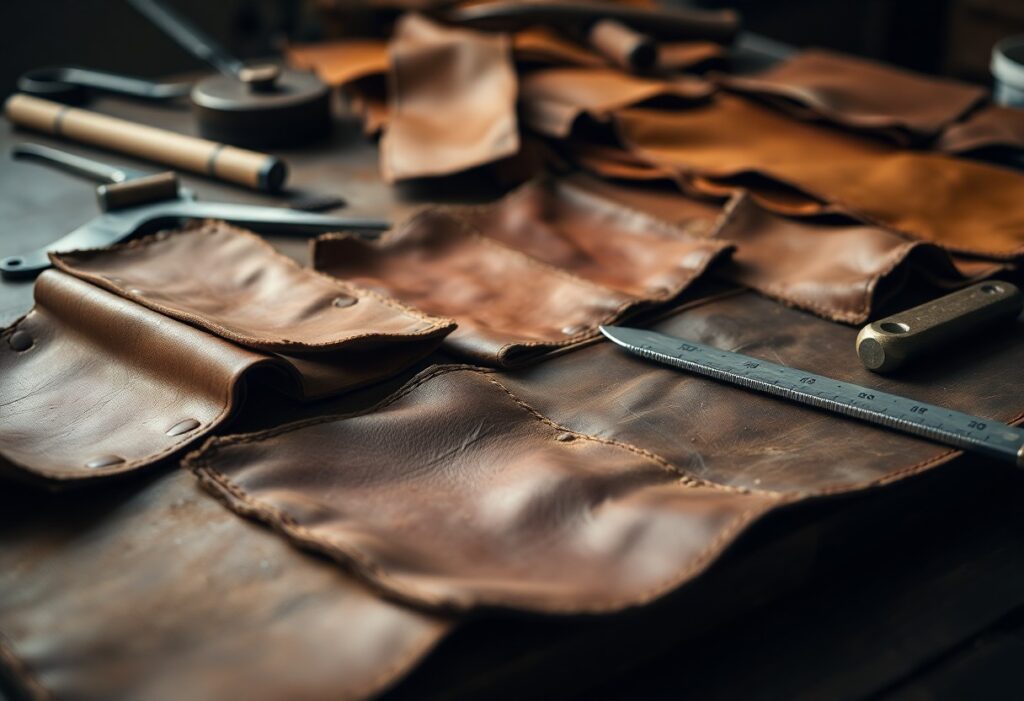
Over the years, leather tanning has evolved into a sophisticated process that directly affects the quality of your final leather products. You’ll find that different tanning methods produce distinct characteristics in leather, from durability and water resistance to texture and color retention. The process begins with raw hides and progresses through various stages including chrome tanning, vegetable tanning, or chrome-free methods. Each method shapes the leather’s properties differently, affecting how you’ll use and maintain your leather goods. Understanding these processes helps you make informed decisions about leather quality and environmental impact, as some methods are more eco-friendly than others.
Types of Leather Tanning Methods
For leather production, there are several tanning methods that transform raw hides into usable leather. The main techniques include chrome tanning, vegetable tanning, and chrome-free tanning. This guide helps you understand the different processes.
| Method | Characteristics |
| Chrome Tanning | Fast, water-resistant, 85% of global production |
| Vegetable Tanning | Natural, eco-friendly, 10% of production |
| Chrome-free Tanning | Environmental-friendly, 5% of production |
| Combination Tanning | Blends multiple methods for unique properties |
| Aldehyde Tanning | Specialized process for specific applications |
Chrome Tanning
Methods of chrome tanning use chromium (III) salts to create soft, flexible leather. You’ll find this process produces leather that’s water-resistant and easy to dye. The process takes 24-48 hours, making it highly efficient for mass production.
Vegetable Tanning
One of the oldest methods uses natural tannins from tree bark and leaves. You’ll appreciate how this process creates leather that develops a rich patina over time and is biodegradable.
Types of vegetable tanning include oak bark, chestnut, and mimosa extracts. You can expect this process to take 4-6 weeks to complete, resulting in leather that’s firmer and more structured than chrome-tanned varieties.
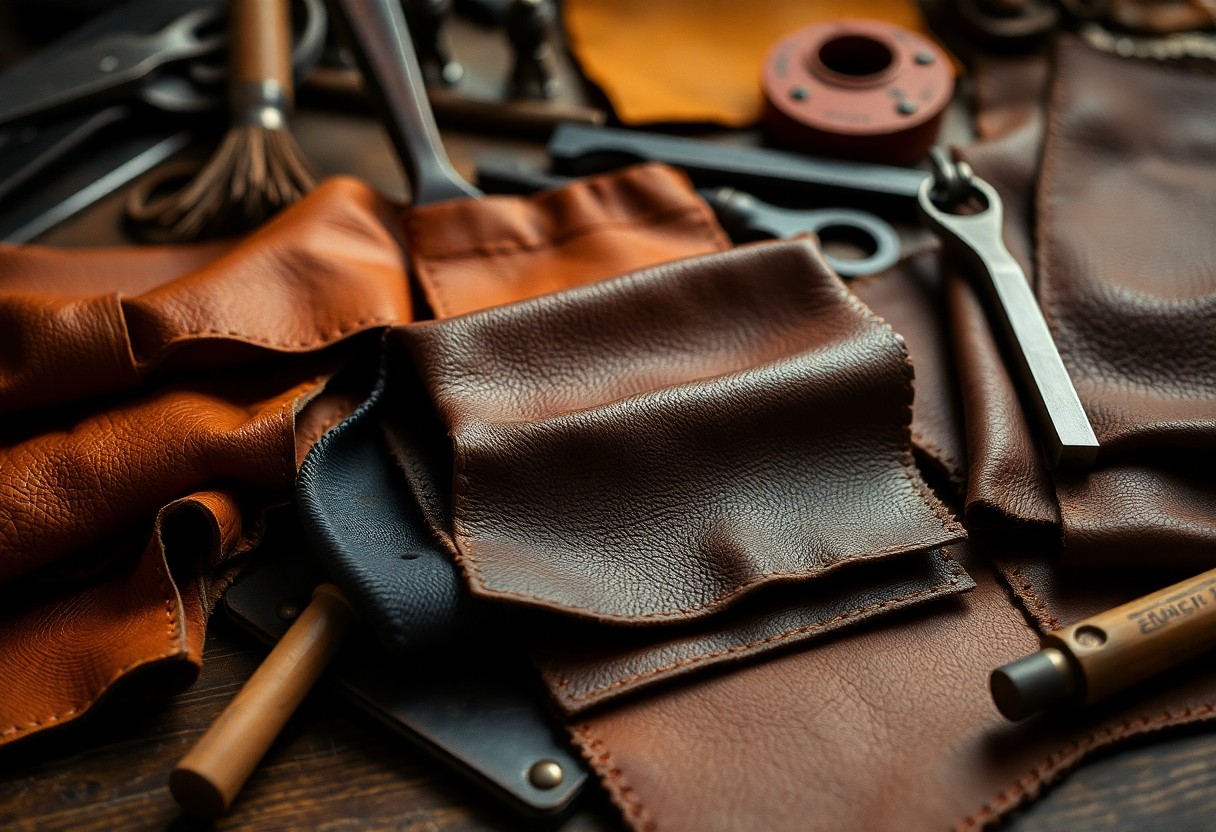
Step-by-Step Tanning Process
You need to follow a structured process to transform raw hides into finished leather. Here’s a comprehensive breakdown of the main steps and their significance in leather quality.
Process Step | PurposeSoaking | Clean and rehydrate hidesLiming | Remove hair and fatDeliming | Prepare for tanningTanning | Convert hide to leatherFinishing | Add color and texture
Pre-tanning Operations
For optimal leather quality, raw hides undergo careful preparation. This includes soaking in clean water for 24-48 hours to remove salt and dirt, followed by liming to remove hair and fats. The process requires precise pH control to prevent hide damage.
Main Tanning Procedures
Pretanning starts with deliming and pickling to prepare hides for the main tanning agents. The most common method is chrome tanning, using chromium sulfate, which produces leather in about 24 hours. Vegetable tanning uses natural tannins but takes 20-60 days.
Another key aspect of tanning is the temperature control during the process. Chrome tanning operates at 35-40°C, while vegetable tanning requires lower temperatures of 20-25°C. The pH levels must be carefully monitored to avoid leather damage and ensure proper tanning agent absorption.
Leather Treatment Methods
There’s a range of methods you can use to enhance your leather’s qualities. From surface finishing to deep penetration treatments, each method serves a specific purpose. You’ll find that proper treatment can extend your leather’s lifespan by up to 50% and improve its resistance to water, heat, and wear.
Surface Treatments
Treatments applied to your leather’s surface include waxing, buffing, and protective coating applications. These methods can increase water resistance by up to 70% and add shine or matte finish according to your preference. You’ll notice that surface treatments also help protect against UV damage and daily wear.
Dyeing Processes
On average, your leather can absorb different types of dyes at varying depths. You’ll find that aniline dyeing penetrates deeply, while surface dyeing creates a more controlled color application. The process you choose affects both appearance and durability.
Plus, your leather’s dyeing process significantly impacts its final characteristics. Drum dyeing can achieve 95% color penetration, while spray dyeing offers more precise color control. You’ll need to consider that natural dyes are safer but may fade 20% faster than chemical alternatives.
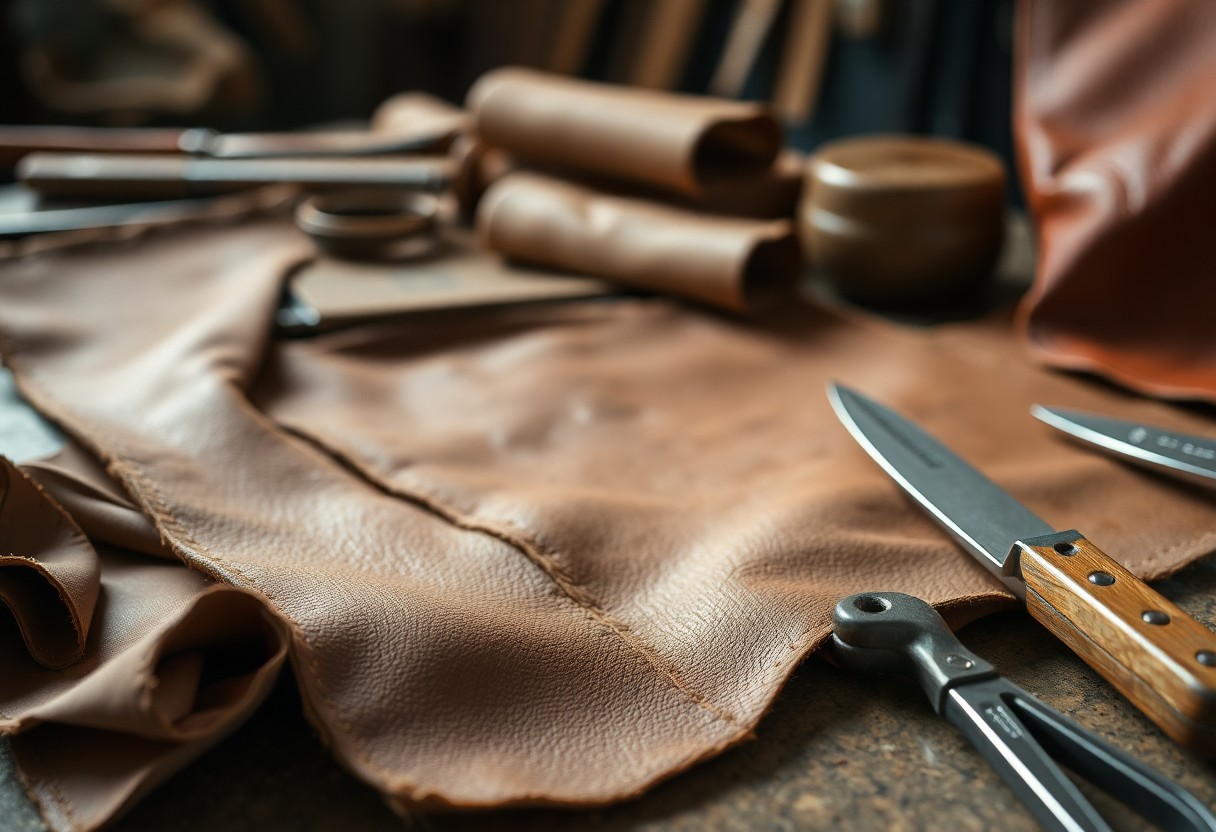
Quality Factors in Leather Processing
Once again, the quality of leather depends on multiple interconnected factors in the processing chain. Your understanding of these elements will help you achieve better results in leather selection and care. The tanning method, hide quality, and processing parameters all play vital roles in determining the final product characteristics. After mastering these factors, you can better evaluate leather quality for your specific needs.
Raw Material Selection
While selecting raw materials, you need to focus on the hide condition and animal source. Your raw material quality directly affects the final leather properties. The best hides come from healthy animals and show minimal surface defects. You should check for thickness consistency and absence of parasitic damage. Select materials based on their intended end-use, as different applications require specific hide characteristics.
Processing Parameters
There’s a direct correlation between processing controls and leather quality. You must maintain precise control over pH levels, temperature, and chemical concentrations. The tanning duration typically ranges from 24 to 48 hours, with temperature controls between 35-40°C. Your attention to these parameters ensures consistent leather quality.
This detailed control extends to every processing stage. You need to monitor moisture content (45-55%), maintain proper drum speed during tanning, and ensure accurate chemical dosing. The drying conditions must be carefully regulated to prevent leather damage. Your careful attention to these parameters results in higher-quality finished leather.
Tips for Optimal Results
Not all leather treatment processes yield equal results. Focus on temperature control, chemical balance, and timing precision during the tanning process.
- Monitor pH levels regularly
- Maintain consistent temperature
- Follow exact chemical ratios
- Document each step
Recognizing signs of proper tanning can help you achieve high-quality finished leather.
Process Optimization
If you want to achieve optimal results, you need to control your tanning environment. Keep your workspace at 20-25°C and maintain humidity between 45-55%. Your chemical solutions should be fresh and properly measured. Regular equipment maintenance ensures consistent results.
Quality Maintenance
Optimal leather quality depends on your storage conditions and handling procedures. Store your leather in a dry, cool place away from direct sunlight. Check moisture content weekly and rotate stock every 30 days.
Process monitoring is crucial for maintaining quality standards. Your regular checks should include pH testing, physical inspections, and moisture content analysis. Document all findings and adjust your procedures based on results. Quality control helps you identify potential issues before they affect your final product.
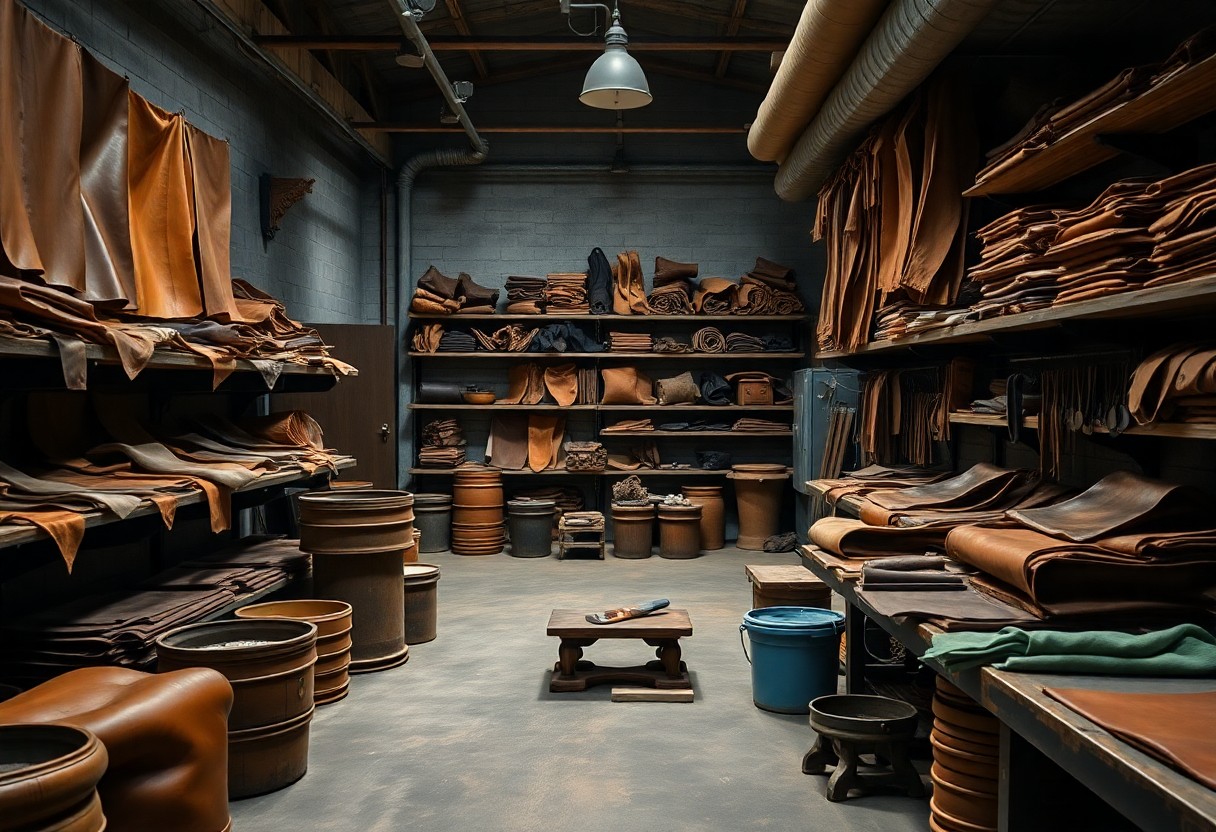
Pros and Cons of Different Methods
To understand leather tanning better, you need to evaluate various methods based on their advantages and disadvantages. Here’s a comprehensive comparison of the main tanning approaches:
Tanning Methods Comparison
| Pros | Cons |
|---|---|
| Chrome tanning: Fast processing, cost-effective | Chrome tanning: Environmental concerns, disposal issues |
| Vegetable tanning: Eco-friendly, natural process | Vegetable tanning: Time-consuming, higher water usage |
| FOC tanning: Environmental safety, good quality | FOC tanning: Complex process, higher cost |
| Combination tanning: Versatile properties | Combination tanning: Complex quality control |
Economic Considerations
Any decision about leather tanning methods will significantly impact your production costs. Chrome tanning offers 85% cost efficiency compared to vegetable tanning, while FOC methods typically increase expenses by 20-30%.
Quality Impact
Even the finest leather can be compromised by poor tanning choices. Your selection of tanning method directly affects durability, water resistance, and texture.
For instance, chrome-tanned leather provides superior water resistance and flexibility, while vegetable-tanned leather offers better aging characteristics and develops a unique patina over time.
To wrap up
From above, you can see how different leather tanning and treatment methods directly affect your leather’s quality and characteristics. Your choice between chrome, FOC, or vegetable tanning will determine your leather’s durability, feel, and environmental impact. The dyeing method you select, whether aniline or crust, influences your leather’s color depth and patina development. Your leather’s finishing type – full grain, corrected grain, or top-coated – sets the standard for its appearance, breathability, and maintenance needs. Understanding these processes helps you make informed decisions about your leather purchases and care methods.
FAQ
What are the main differences between chrome tanning and vegetable tanning?
Chrome tanning uses chromium salts and creates soft, water-resistant leather quickly and cheaply. It makes up 85% of global leather production. Vegetable tanning uses natural tannins from tree bark and leaves, takes longer, and produces leather that develops more character over time. Vegetable tanned leather is more environmentally friendly for disposal but stains more easily than chrome-tanned leather.
How does aniline dyeing affect leather quality and appearance?
Aniline dyeing involves immersing leather in dye baths that penetrate the material. This method creates an even color throughout the leather and provides excellent color retention. Modern aniline-dyed leather is often dyed partially through rather than completely, keeping the middle layer light colored. This makes the leather more stable while maintaining good color depth on the surface.
What makes full grain leather different from corrected grain leather?
Full grain leather keeps the natural surface intact without sanding or artificial covering. It shows natural pores, has the strongest fiber structure, and can be restored when scuffed. Corrected grain leather has been sanded down and covered with a plastic layer. While corrected grain is easier to clean and maintain, it doesn’t breathe well and can crack over time with no way to repair the damage.

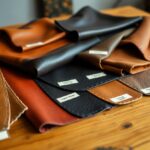
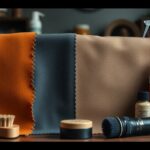





The evolution of leather tanning truly reflects the balance between tradition and innovation, which is increasingly relevant in today’s environmentally conscious climate. I appreciate how you highlighted various techniques such as chrome tanning, vegetable tanning, and chrome-free methods, as these processes not only underpin the quality and characteristics of leather but also showcase the significant interplay between craftsmanship and ecological responsibility.
It’s refreshing to see someone appreciate the nuances of leather tanning like you do. The balance between tradition and innovation really is fascinating. When you dive into the methods, it’s clear that each technique brings its own flavor to the final product.
You’ve touched on something quite profound about leather tanning. It’s interesting how deeply embedded tradition can influence modern practices while also allowing for innovation. I’ve read about how some artisans are experimenting with plant-based tannins, which not only honor traditional methods but also appeal to a growing demand for more sustainable practices.
You’ve touched on an important aspect of leather tanning that often gets overshadowed by the industry’s rapid advancements. The balance between tradition and innovation is a fascinating dance. It’s intriguing how techniques like vegetable tanning harken back to ancient practices yet remain relevant as we reassess their environmental implications in today’s market.
You’ve really hit a chord with that observation. The dance between traditional and modern methods is something I find fascinating too, especially in industries like leather tanning. Vegetable tanning is such an interesting case; it’s a process rooted in history but feels refreshingly relevant today as we start to prioritize sustainability.
You’ve highlighted a key tension in the leather industry that really draws attention to how we approach sustainability. Vegetable tanning, with its roots in ancient methods, shows us that some traditions hold value that can transcend time. As consumers become more aware of environmental impacts, there’s a growing demand for transparency and eco-friendly choices.
You’ve really captured the essence of what leather tanning represents today. It’s fascinating how these traditional methods and modern techniques are merging to create something that speaks to both heritage and progress. Chrome tanning, for instance, has its roots in efficiency and speed, and yet it raises questions about environmental impact that we can’t ignore anymore. On the flip side, vegetable tanning is like a throwback to when craftsmanship was paramount; it takes much longer, but the results often have a unique character and rich history that many consumers are starting to appreciate more.
You’ve touched on a really important aspect of leather tanning that many people don’t always consider. The evolution of these techniques indeed highlights that delicate balance between maintaining traditional craftsmanship and embracing the need for sustainability. It’s fascinating how processes like vegetable tanning, though much older, are gaining renewed interest as people seek out more responsible practices.
I found this insightful guide on nubuck suede and roughout leather that really complements the discussion on different tanning methods and their impact on both quality and care.
‘Guide to nubuck suede and roughout leather differences care tips and uses’
https://myshoesfinder.com/nubuck-suede-and-roughout-leather-care-tips/.
This exploration of leather tanning methods truly sheds light on the intricate journey from raw hide to a beautiful leather product. It’s fascinating how the choice of tanning can not only influence the aesthetics of leather but also its longevity and ecological footprint. Personally, I’ve always been drawn to the uniqueness of vegetable-tanned leather. Each piece tells a story, aging gracefully and developing a patina that reflects its life experiences.
It’s fascinating to see how the art and science of leather tanning have evolved over time. I particularly appreciate how you highlight the differences between tanning methods and their implications for both quality and environmental impact. I recently learned about the growing interest in using plant-based tanning methods, especially among artisans who focus on eco-conscious production. It’s encouraging to see that more consumers are prioritizing sustainability and supporting brands that embrace these methods.
It really is fascinating to see how the art and science of leather tanning have evolved over time. You hit on a crucial point regarding the differences between tanning methods and their implications for quality and environmental impact. With plant-based tanning methods gaining traction, it’s interesting to think about how traditional practices are being revisited and adapted to meet modern values around sustainability.
You bring up some excellent points about the evolution of leather tanning and the ongoing shift towards more sustainable practices. The contrasts between traditional and modern methods are not just about how the leather is produced but also reflect changing societal values. As consumers have become more conscious of environmental issues, the demand for eco-friendly practices has certainly pushed the industry to adapt.
It’s fascinating to see how the art of leather tanning has evolved over the years, especially considering its deep-rooted history. I remember when I first learned about the differences between chrome and vegetable tanning; it completely changed my perspective on leather products. The eco-friendly aspect of vegetable tanning really resonates with me, especially in today’s world where sustainability is becoming more crucial.
It’s great to hear that you’ve had a shift in perspective about leather products. The distinction between chrome and vegetable tanning is indeed a significant one. While chrome tanning has its benefits, it’s hard to ignore the advantages of vegetable tanning, especially in our current climate. Many consumers are seeking products that are not just high-quality but also aligned with eco-conscious values.
I appreciate your exploration of the different leather tanning methods and their impacts. It’s fascinating how the choice of tanning can affect not only the physical characteristics of leather but also its sustainability. For instance, vegetable tanning is often celebrated for being more eco-friendly, yet the longer process can mean higher costs and less consistent results.
It’s true, the nuances of leather tanning methods really do shine a light on the broader conversation around sustainability in our consumer choices. I find it intriguing how the traditional vegetable tanning process, while more eco-friendly, can often leave artisans and companies in a bit of a bind financially. It’s a classic case of quality over quantity, where the craft takes precedence but at a cost.
You’ve touched on an important aspect of leather tanning that often gets overlooked. The trade-offs between the eco-friendliness of vegetable tanning and its challenges in terms of consistency and cost can feel like a real balancing act.
I truly appreciate the depth you’ve brought to the discussion about leather tanning methods and their implications for quality and sustainability. It’s fascinating to think about how something as seemingly straightforward as leather can embody such intricate processes that reflect both craftsmanship and environmental awareness.
It’s great to see how much you appreciate the nuances of leather tanning methods. The craftsmanship involved really does tell a story, doesn’t it? Each method can influence not just the final product but also the relationship consumers have with materials. When we think about sustainability in this context, it raises interesting questions about production practices and environmental ethics.
Ah, the art of leather tanning—who knew it could evoke such passion? I must say, if I had a dollar for every time I mistook a chrome-tanned leather for its vegetable-tanned cousin, I’d be able to buy a whole new wardrobe made from sustainably sourced materials. But I digress!
It’s fascinating how leather tanning can sweep us into such discussions, revealing not just the craft itself but the broader implications of our choices—especially related to sustainability. Your experience with mistaking chrome-tanned leather for vegetable-tanned really speaks to how nuanced the world of leather can be, and it highlights a common pitfall many face when diving into this field.
The nuances between chrome-tanned and vegetable-tanned leather can be quite puzzling at first. It’s interesting how these processes can yield such different results in texture, color, and environmental impact. While chrome tanning offers that lovely softness and vibrant color, it does come with some environmental concerns. On the other hand, vegetable tanning, while more sustainable, often has a more rigid feel and can take on beautiful patinas over time.
It’s fascinating to think about how the choice of tanning method can not only influence the aesthetics of leather but also its functionality and longevity. When I first learned about vegetable tanning, I was drawn to its natural process and how it often results in leather that ages beautifully, developing a rich patina over time. However, I’ve also come to appreciate the rapid production methods like chrome tanning for their efficiency and ability to produce consistent results.
It’s great to see such enthusiasm for the nuances of tanning methods. You hit the nail on the head with how the choice of tanning can impact not just the aesthetics but also the functionality and longevity of leather. The journey through vegetable tanning is indeed captivating. There’s something quite remarkable about the way it utilizes natural materials and takes its sweet time to develop an elegant finish. The unique character that emerges as it ages, complete with those beautiful patina changes, really does tell a story. Each scratch and variation reflects the history of the leather and adds to its charm.
What an intriguing dive into the world of leather tanning! It’s fascinating how a seemingly straightforward process can lead to such a variety of leather characteristics. I mean, it’s like the difference between a fancy espresso and that sad, lukewarm cup of office sludge. Sure, they’re both coffee, but the experience of sipping either can differ astronomically!
It’s interesting that you brought up the analogy of coffee when discussing leather tanning. It illustrates how perceptions can shape our experiences, particularly in materials. Just like with coffee, the variation in leather’s quality and characteristics often relies on the details of its creation and the choices made throughout the process.
It’s great to hear your perspective on leather tanning! That comparison to coffee really highlights what we often overlook in the details of craftsmanship. Just like with coffee, the nuances in leather come from the material itself and the care taken during the process.
It’s fascinating to delve into the intricacies of leather tanning and its significant impact on the final product. I’ve always been intrigued by how much the method of tanning can influence not just the durability and aesthetics of leather but also its environmental footprint. For instance, while chrome tanning offers quick production times and vibrant colors, it’s also a process that generates considerable waste and potentially harmful byproducts. On the other hand, vegetable tanning, though more time-consuming, not only allows for greater biodegradability but also lends a unique rustic charm to the leather, enhancing its character over time.
You’ve touched on some really important points regarding the complexities of leather tanning. It’s interesting to consider how our choices in methods reflect not just on the final product but also on our environmental responsibilities. I’ve also thought about how the speed and convenience of chrome tanning can often overshadow the longer, more traditional processes like vegetable tanning, which, as you noted, brings out a unique character in the leather.
Your exploration of leather tanning methods truly highlights the complexity of this age-old craft, which often goes unnoticed by consumers. It’s fascinating how the choice of tanning can impact not only the final product but also the environmental implications associated with leather goods.
It’s true that leather tanning methods are often overlooked, and it’s intriguing how these age-old practices intertwine with modern concerns. The shift toward more environmentally friendly tanning processes, like vegetable tanning, has definitely gained traction, but it’s clear there’s still a long way to go.
It’s fascinating to see how the evolution of leather tanning methods has shaped the industry and our interactions with leather goods. I remember when I first started exploring leather crafting as a hobby, I was drawn to the tactile nature of the material. Understanding the different tanning methods really opened my eyes to what I was working with.